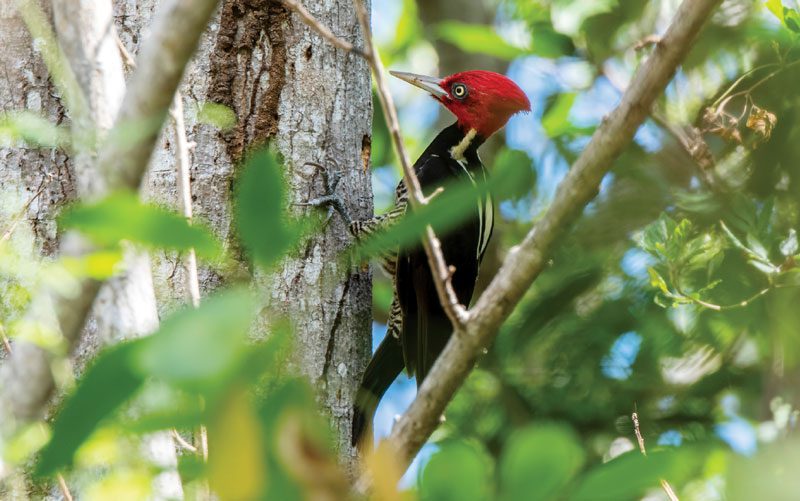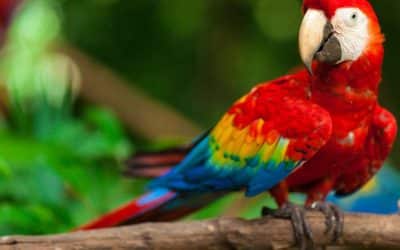Diria National Park: One of Guanacaste’s Least-Known Attractions. Northern Guanacaste and the Nicoya Peninsula have several well known national parks: the history-rich Santa Rosa, the caves of Barra Honda, the marine preserve and turtle nesting grounds of Las Baulas and the wetlands of Palo Verde — now one of the top birding destinations in the world. But few know about or have visited the wonderful Diria National Park near Santa Cruz. It is the least visited locale in Costa Rica’s national park system, with even fewer tourists than the rarely visited La Cangreja Park, which was featured in the December 2018 Howler issue.
The 5,500-hectare park (over 10,000 acres) was created only recently, in 2004. A key objective was to protect more than 380 species of trees that forest the area — many original old growth saved from the deforestation of the mid-20th century — as well as several rivers flowing out of the mountains creating the Santa Cruz region’s water supply. Diria National Park is also the home of rare and endangered bromeliads and cacti, along with a special group of orchids that can survive the extreme dry season conditions.
For anyone visiting the northern Nicoya area, a day trip to Diria can give you a totally different Costa Rica experience.
When to go
If you’re seeking a great place to hike or mountain bike, see lots of birds and animals along with rare and endangered plants or even just cool off from the heat, you will enjoy Diria. The park has two major areas: the lowland tropical dry forest around the casona (park ranger station) and the tropical humid forests covering much more mountainous terrain, rising to 1,800 meters (almost 6,000 feet) above sea level.
The casona vicinity has three hiking trails that follow the rivers through the dry forest. The longest trail leads to beautiful Brazil Falls, requiring a demanding hike through rugged conditions. The park’s main facilities are located at the casona, accessible only by fording a river. Many opt not to drive through, especially in rainy season. The casona has restrooms and is equipped for overnight stays and meals if booked in advance, especially for groups.
The rest of the park site can be reached by driving, or more recently, using a system of bike trails extending upward … and further up. You can drive to the crest of the Nicoya Peninsula’s highest mountain ridge, looking back to the mainland and even sighting Palo Verde National Park.

Animals and birds abound throughout Diria and change with the elevation. Howler monkeys, iguanas, anteaters and deer can be seen. Birding is also great here, with more than 140 species that include pale-billed woodpecker, barred antshrikes and long-tailed manakins. All are easily seen in the park, as well as the beautiful elegant trogon, which is found only in the northern Nicoya Peninsula.
How to get there
First drive to Santa Cruz, from the west taking route 152/route 160 east, or from the east taking route 21. From there, take the road south to Arado; drive around the Arado soccer field and you will see a sign to Diria National Park. The road becomes gravel for the final 6 kilometers. Follow signs to Diria National Park (a 4WD vehicle is recommended). Signs to the park casona take you to the lowland trails (remember you must cross a river) and those marked Los Angeles lead up the mountain. When you reach the ranger station, don’t be surprised if it’s unoccupied; the park has few rangers and those on duty are likely out patrolling, especially when there’s a risk of forest fires during dry season. Many park visitors leave their admission fee on the desk.
For anyone visiting the northern Nicoya area, staying in Tamarindo or other beach spots, a day trip to Diria can give you a totally different Costa Rica experience. It can even cool you off a bit, as a bonus for enjoying some real wilderness.
 When to visit
When to visit
As applies to most places in Costa Rica, the best time for visiting Diria is between December to April. However, visiting in the rainy season can be a treat if you visit Brazil Falls, which quickly dries out in summer. The downside is that rainy season conditions can be difficult for getting around and the roads might be impassable.
Rincon de la Vieja – Things to do
4×4 Lake Arenal – road to El Castillo
Lucky Lovers Leap into an adventure of a lifetime
Lake Arenal – Lost Canyon Adventure
Gone Fishing: worst day fishing beats the best day working
Seven Days in Costa Rica: Arenal, Dominical and More
Lake Arenal: Safari River Float is a slow boat to paradise
Gone Sailing in Guanacaste Costa Rica
Cocos Island, Costa Rica’s treasure
Stand Up Paddle boarding SUP
ATV Tours, Take the road not taken
Deep Sea Fishing, Fun and Flamingo Costa Rica
White water rafting in Costa Rica
Scuba Diving in Costa Rica
Costa Rica Combo Adventure Parks
Authentic Costa Rica: What to do in rural Bijagua
Blue River Resort and Hot Springs







